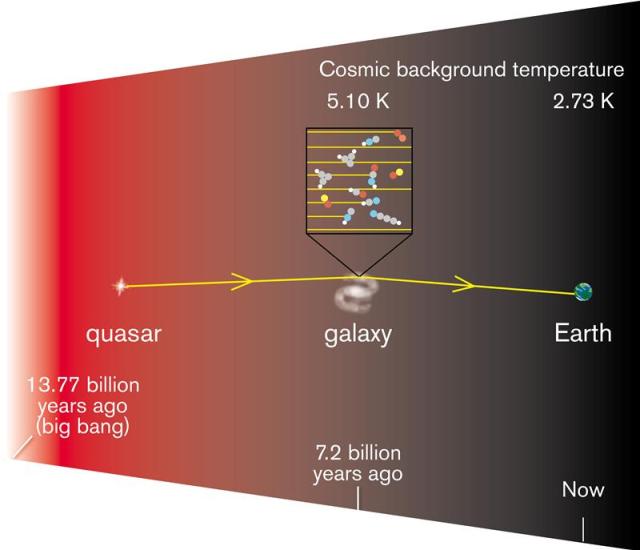Jan 23 2013
Astronomers have put the Big bang theory through a tough new test - by measuring the temperature of the universe when it was half as old as it is now.
 Radio waves (yellow lines) from a bright quasar pass through a galaxy where they are absorbed by molecules in a cold cloud of gas. Astronomers used radio telescopes to measure the temperature of the universe 7.2 billion years ago by measuring the signatures of the molecules in the radio waves. Credit: Onsala Space Observatory/R. Cumming/S. Muller
Radio waves (yellow lines) from a bright quasar pass through a galaxy where they are absorbed by molecules in a cold cloud of gas. Astronomers used radio telescopes to measure the temperature of the universe 7.2 billion years ago by measuring the signatures of the molecules in the radio waves. Credit: Onsala Space Observatory/R. Cumming/S. Muller
A team of scientists led by Sebastien Muller (Chalmers University of Technology and Onsala Space Observatory) has made the most precise measurement ever of how the universe has cooled down during its 13.77 billion year history.
They studied molecules in clouds of gas in a distant galaxy, so far away that its light has taken half the age of the universe to reach us. To make the measurement they used the CSIRO Australia Telescope Compact Array, an array of six 22-metre radio telescopes in eastern Australia.
"When we look at this galaxy with our telescopes, we see it as it was when the universe was younger - and warmer - than it is now", says Sebastien Muller.
The astronomers used a clever new method to measure the temperature of the cosmic microwave background – the very weak remnant of the heat of the Big bang that pervades the entire universe. They observed radio waves from molecules in a galaxy so far away that its light has taken 7.2 billion years to reach us.
“The gas in this galaxy is so rarefied that the only thing keeping its molecules warm is the cosmic background radiation – what’s left of the Big bang”, says Sebastien Muller.
Taking advantage of a lucky alignment, the team measured light from an even more distant source behind the galaxy, a quasar known as PKS 1830-211. The quasar is a young galaxy which shines brightly because of jets from a supermassive black hole at its centre.
“We analysed radio waves from the quasar which had passed through the gas in the galaxy. In the radio waves, we could identify traces of many different molecules”, says Sebastien Muller.
Using a sophisticated computer model, the astronomers used these molecular signatures, left like fingerprints in the light from the quasar, to measure the temperature in the gas clouds in the intervening galaxy.
The temperature of the cosmic background radiation they measured was 5.08 Kelvin (+/- 0.10 Kelvin). This is extremely cold, but significantly warmer than the temperature which scientists measure in today's universe, 2.73 Kelvin. Scientists measure temperatures in Kelvin above absolute zero (0 Kelvin = -273 degrees Celsius). One Kelvin is the same size as one degree Celsius.
"The temperature of the cosmic background radiation in the past has been measured before, at even larger distances. But this is the most precise measurement yet of the ambient temperature when the universe was younger than it is now", says Alexandre Beelen, astronomer at the Institute for Space Astrophysics at the University of Paris, France.
According to the Big bang theory, the temperature of the cosmic background radiation drops smoothly as the universe expands.
"That's just what we see in our measurements. The universe of a few billion years ago was a few degrees warmer than it is now, exactly as the Big bang theory predicts", concludes Sebastien Muller.